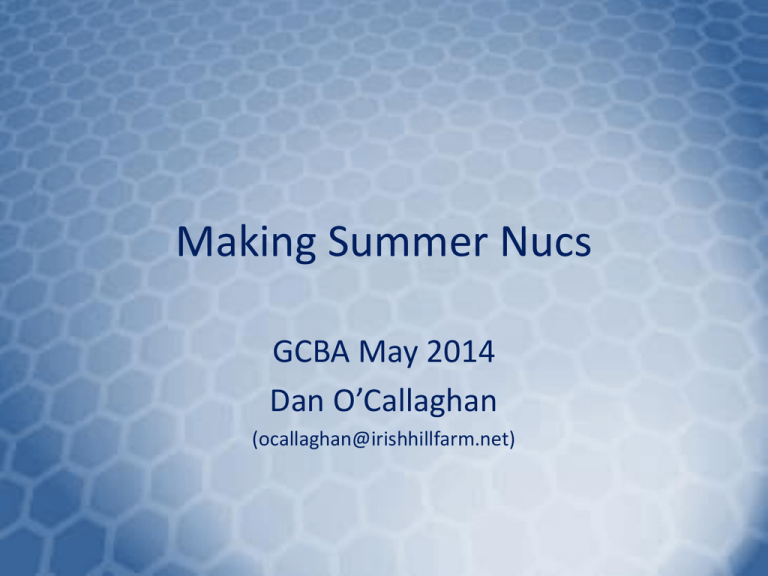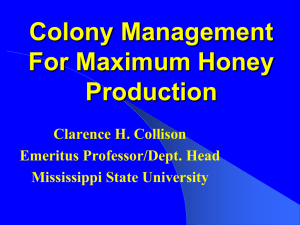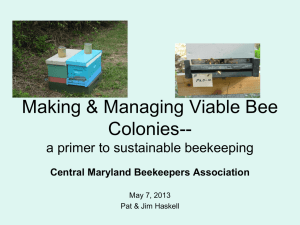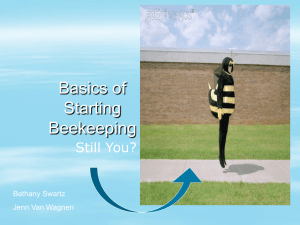Link to Dan O`Callaghan`s Nuc slides from May 2014 Meeting
advertisement

Making Summer Nucs GCBA May 2014 Dan O’Callaghan (ocallaghan@irishhillfarm.net) Definitions (for remainder of this presentation) • Split – Making a new colony from an existing – making a nuc is a type of split. • Nuc – A Nucleus Hive, a 3-5 frame colony Why Nucs? • Save $$ replacing losses •Increase production (more hives) •Decrease production (less hives/fewer bees) •Prevent swarming •Produce bees for sale •Re-queen or raise queens •Deal with ‘hot’ hive •Mite control •??? Using Nucs • Many recommend maintaining several nucs – 1 nuc per 2 hives common, 1 – 1 gaining popularity • Some uses (other than selling bees) – Keep ready queen replacement on-hand – Augment hives during flow – Queen rearing – Summer increase for overwintering • Create nucs in summer, overwinter for rapid expansion in spring • Details in Larry Connor’s “Increase Essentials” and/or kirkwebster.com Nucs What is a Nuc? • A nuc is a mini-hive containing a small colony of bees, typically 3-5 frames. • May be in own box or in divided standard box This is a picture of Joe Latshaw with some of his nuc’s. Joe specializes in raising queens. (pic “borrowed” from Dana Stahlman presentation) Nuc Boxes Commonly used options to house nucs • Buy/Make nuc boxes sized to hold 3-5 frames – – – – Solid bottom Removable bottom ‘mini-hive’ Deep – Medium – Shallow Polystyrene (Styrofoam) • Divider board(s) w special bottom boards to split full size ‘standard’ box into separate chambers. • Mini mating nucs/frames for queen rearing Some Nuc Box Examples Finding the queen? • Very important to find the queen/know where she is when splitting or making nucs • Methods: • Visually find old queen while splitting (very time consuming, not always possible or effective) • Use queen excluder(s) to confine queen to 1 box 4-5 days prior to split (requires 2 visits) • Split without finding, check 4-5 days after split, look for eggs, re-queen box with none (not efficient for production hive, queenless period, requires 2-3 visits) Making Nucs • Typical Nuc creation 1. May use single or multiple ‘donor’ hives 2. In each nuc chamber, add: • • • • 1 - 3 frames of brood/bees Shake bees from 2-3 other brood frames 1 – 2 frames stores (honey & pollen) Frames of foundation/comb to fill 3. Queen • May re-queen as in standard split • May move old queen from donor hive • May let them raise own queen Making Nucs • How many frames of brood/bees? – Deep frame has about 6,400 cells • @75% emergence, about 4,800 bees/frame – About 1/2lb (1600) nurse bees needed to cover each frame of brood – Laying queen about 1,000-1,200 eggs/day How many frames of brood/bees? Chart from “Increase Essentials, Larry Connor (slide) Early Season Nucs • 4-way (Mississippi) splits: 1. 2. 3. 4. 5. Requires 1 strong double-chamber hive All resources – bees, brood, stores – are divided equally into 4 separate units. May be in divided chambers, most often centered in singledeeps with remaining space filled with frames foundation/comb Usually all 4 are re-queened Usually require feeding as flow has not started and goal is to get them into production ASAP • Used by commercial pollinators for rapid early season build-up/increase • Good method for dealing with large ‘hot’ hive • MUST have queens as no drones available for mating Mid-Season Nucs • Usually used for swarm control. Goal is to keep production hive intact but stop swarming. 1. 2. 3. 4. 5. Strong, crowded production hive, with or without queen cells Amount of bees/brood/stores varies. If more than 2 frames of each need to be removed, consider multiple nucs If queen cells available, cells go into nucs, queen stays with original colony If no queen cells, must add at least 1 frame of eggs and open brood if letting bees raise their own queen Feeding is not usually required as the flow is in progress • Letting bees raise their own queen is usually viable as drones are available during swarm season. • Also a good method for preserving an ‘old’ queen rather than ‘squish’ during spring-requeening Late-Season Nucs • Used mainly for overwintering – getting “off the bee package treadmill” 1. Select from good production hives 2. Use the minimum amount of bees and re-queen method necessary to make a healthy population in the time between make-up and winter. 3. Queen method varies – raise own, cells, locally raised 4. Feeding is variable. If flow is steady, not needed, if dearth, is required. • Letting bees raise their own depends on time/flow/drone availability. • Overall goal is population strong enough to survive winter without exceeding nuc box capacity Late-Season Nucs • Select from good production hives. Some traits: – Queen productivity – Colony Productivity – Colony Temperment – Hygenic behavior – Survivor/Resistant stock – ??? (photos plagiarized from Dana Stahlman) Late-Season Nucs • Use the minimum amount of bees and requeen method necessary to make a healthy population in the time between make-up and winter (chart). Some variables: • Time of year/temperature • Flow or dearth status • Queen method on population growth start • Laying queen ~week • Virgin queen/cells ~3weeks • Raise own queen ~5-6 weeks Late-Season Nucs • Feeding necessity requires monitoring and may change throughout the season. • Early summer, may not need during flow • Mid-summer, probable dearth, must feed • Early fall, depends on flow • If more than 1 or 2 frames are foundation, best bet is to feed regardless of flow Overwintering Nucs • Suggested timeline: • Mid-June, make nuc with one frame of brood & queen cell • Late June/early July, monitor for feeding requirements • Late July, begin feeding • Late Fall/early winter, when temp consistently below 50, crowd nucs together (optional) • Winter – emergency feed if needed • Early spring – move survivors into full-size boxes as needed. Photos courtesy of Dr. Joe Latshaw References • www.honeybeeworld.com/spring/splits.htm • “Increase Essentials” by Larry Connor. • Dana Stahlman OSBA presentations: “Summer Management” “Management of Nucs” • Dr. Joe Latshaw latshawapiaries.com/uploads/wintering-nucs.pdf








